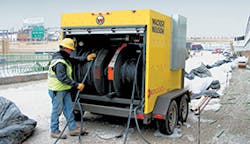When I was a teenager in the mid 1960s, my father was an officer stationed at Elmendorf Air Force Base in Anchorage, AK. At the time, the Vietnam War was ramping up, and as a result, medevac and cargo aircraft were a common sight on the flightline as they arrived from the war zone for refueling and maintenance.
From time to time there would be a fire or some other emergency to which fire crews would respond to fight a blaze or to be prepared in the event of one. Each member of the fire crew was dressed in heavy metallic suits which protected them from the heat of the blaze, but due to the mist of water coming from their hoses, many of the firefighters would eventually become coated with ice, making it impossible for them to move, or if they fell over, even to get up. Specially trained dogs would run up and down the fire lines to let another crewmember know when there was a man down and needed help getting back on his feet. Fortunately, for the amusement of my friends and I, each fireman had a large number stenciled on his back, which allowed us to stand in the terminal with binoculars and make bets with each other as to which man would fall over first, second, third, and such.
All of this makes for a great story, not to mention a funny mental image, but it is also an excellent illustration of the difficulties and dangers of working in extremely cold weather, a situation that is endured not only by fire crews in Alaska, but those engaged in many occupations that are practiced in cold weather. And this problem doesn’t just extend to humans, but to the machines they operate. Plainly stated, many machines simply are not built to operate in extremely cold weather, and in these cases, workers often go to extreme lengths to get the job done. Further, with considerable help from the makers of this equipment, the work more often than not does get done, along with a lot of unintended R&D completed along the way.
Harder Than Concrete
Ed Jaroszewicz, a representative of Wacker Neuson, considers working in cold climates to be a multi-faceted problem. “Most people underestimate the additional variables cold weather challenges a jobsite,” he explains. “Typical variables include windy conditions and how it “˜scrubs’ BTUs from structures, materials and workers, the mass of snow or in extreme northern climates, “˜white outs,’ frozen ground or ice which is often harder than concrete, and logistic and process delays, exposing the jobsite to schedule delays.”
Jaroszewicz is quick to point out that despite cold weather, it is often still cost efficient to keep working on a project, despite cold weather, in fact, in instances such as:
- Curing”“ pour quality concrete in cold weather, reach design strength sooner, all concrete applications, no enclosures to build, fuel savings of 50% or more. Total cost is between $0.20″“$0.30/ft².
- Thawing”“ Thaw large areas fast, save time and money. Total cost is between $0.10″“$0.15/ft³.
- Indirect air heating”“ Clean air, remove access moisture, no noxious fumes, dry warm air, safe heat, no open flames. Total cost is between $0.04″“$0.06/ft³.
Jaroszewicz also points out that there are certain projects that are more advantageous to work in the cold. “Ironically, many contractors have stated that managing uniform concrete temperatures is much easier when using surface heaters,” he explains. “Excavating an area after frozen ground has been thawed is easier since the frozen boundary ground remains frozen.”
Indoor construction activities can progress faster using clean, dry air from indirect heaters. In some geographical areas, winter conditions are dryer than in summer months. With construction processes introducing high volume of moisture or water into the work area (i.e. adhesives, paint, drywall, etc.), using indirect heaters can better manage interior’s relative humidity and speed up those processes and project schedules.
Jaroszewicz also offers the following creative hacks for those who are about to work in the extreme cold:
- With more low sulfur diesel in North America, this fuel has more water content and can begin to jell much faster than previous fuel grades. It is highly recommended to use a winter blend to insure consistent combustion for diesel heaters.
- Consider smaller placement areas than what may be used during warmer months. It is easier to manage.
- Traditional direct fired heaters cause many problems to construction activities.
- Noxious fumes could leak.
- Large fuel bills may be incurred due to heat stratification.
- There could be uneven heat distribution.
- You may get concrete curling (around the outer cold edges of a concrete placement and chalking caused from hydrocarbons mixing with fresh concrete.
- When removing frost, moisture is critical to conduct surface heat downward.
Race Against Time, and Weather
Jim Siffring, generators product manager of Atlas Copco, is intimately familiar with the problem of operating equipment in cold weather. In fact, he’s been assisting companies that purchase his products wherever they might be using it, from the hottest deserts to the coldest climes.
“Anyone who wants to manufacture a piece of equipment such as, in our case, a generator, can’t just build it for use in one particular climate and then ship it out and hope for the best,” explains Siffring. “That’s foolhardy. A good manufacturer builds equipment that is made to accomplish a particular task, and if it happens to be intended for use in a cold climate, so be it, and if there is a problem with that machine operating efficiently in a cold climate, that’s where the manufacturer and the user need to work together to create a solution. This is a situation where a good dealership network is very useful. A good dealer network can be a serious augmentation of the company staff.”
When it comes to user R&D, Global Air Products Manager Russ Warner and Global Generator Products Manager Todd Howe, both of Doosan Portable Power, are in complete agreement. In fact, both believe that working with users throughout the equipment development process, extending to after-purchase support is critical to the success of any company that works with their clients, regardless of where they are.
“Whatever the location might be, chances are good that we have equipment that is being operated by users in the area,” explains Warner. “And as long as that is the case, it’s important for us to be able to make sure that our equipment operated at top efficiency wherever it is. Anything less is not acceptable.”
There are two main areas of concern for products used in cold weather-safety and function the ability of the equipment to maintain its operational properties at low temperatures is of major importance. Low temperatures affect both the properties of the materials used in the construction of the equipment and the properties of the atmospheres to which the equipment can be exposed. Functionality of the electrical equipment can also be altered or negatively affected by cold temperatures. This paper will examine factors affecting the safety of equipment in areas classified for explosive atmospheres as well as the functionality of electrical equipment at low temperatures.
Independents
When just a separate heater will do the job, Kenway Engineering Inc. of Fairmont, MN, has introduced a flameless HVAC unit for off-road construction equipment unlike any previous hydraulics-based operator cab climate control systems. The Kenway 9067 Series is the product of four years in-the-field use, both as OEM and retrofit equipment.
The Kenway 9067 Series is a completely re-engineered and redesigned operating system that offers more power, greater reliability and a lower cost of operation than the industry has ever seen before from a flameless HVAC unit.
Ideal for off-road construction equipment at jobsites that restrict or prohibit heaters running on propane or diesel fuel, the Kenway 9067 Series can be installed as a split unit system or as a self-contained model about the size of a small window air-conditioner. As a self-contained unit, Kenway 9067 Series installation requires a rectangular opening in the cab wall, four hose connections and a single electrical hookup.
Flameless Means Hydraulic
Kenneth Detloff, co-owner of Kenway Engineering, says, “People in this industry have been looking for a better solution than what’s been available. More jobsites are requiring flameless solutions, and flameless means hydraulic. We have the solution. It’s available right now.”
Detloff says that in addition to its reliable performance, the Kenway HVAC unit also offers low cost of ownership. “Our system does not require tanks of propane or diesel fuel, and there is no hydraulic oil reservoir or filter in our system to maintain, which eliminates those regularly scheduled service steps.”
Rey Carlson, Kenway’s chief engineer, says the Kenway heat system has carefully designed hydraulic circuits that protect the pump, valves, and seals from damage caused by oil breakdown and pressure and flow fluctuations. “The hydraulic power we use is only used to heat the cab, so our system has no thermal impact on the crane’s oil reservoir.”
Since the Kenway 9067 Series does not rely on engine heat to run an antifreeze/coolant-based HVAC system, the unit works just as well with cooler-running EPA Tier 4 engines as it does with pre-compliancy engines.
Detloff says, “One customer told me his Tier 4 engines were only putting out about 100 degrees [Fahrenheit] at the engine, and only 66 degrees at the heater fitting. You’ll never heat a crane cab in northern Canada with those coolant temperatures. On the other hand, our hydraulic units can output 27,000 BTU per hour at idle. The hydraulic oil in our heat circuit can go as high as 205 degrees. Canadian crane operators in the dead of winter actually turn our heater down.”
Adaptable, Efficient, Smart
The system is highly adaptable for a wide variety of heavy equipment. Kenway Engineering can design units to suit any OEM interior cab scheme, and the compact size of the hydraulic drive unit can fit just about anywhere.
Carlson designed the system and its key components. Addressing crane cabs specifically, Carlson says: “All other crane HVAC systems suffer from thermodynamic inefficiencies. The compressor might be hidden deep in the engine compartment, while the evaporator and heater core are in the cab. The distance requires multiple hoses and connections, and a hydraulic swivel to transfer the engine coolant and refrigerant from the chassis to the cab. The result is pressure and flow losses and temperature changes.”
In addition to thermodynamic inefficiencies, other HVAC systems present another complication. Carlson says, “These fluids are not compatible with the hydraulic swivels so they need to be specially designed to handle them. Service and maintenance is harder and more expensive with these systems. Every additional connection and swivel seal represents a potential leak point and a service and repair item.”
The design of the new system eliminates these concerns, Carlson says. “Self-contained or split system, everything is right there.”
The Kenway 9067 Series system is a 6th generation design, Carlson says. “It is by far the smartest. We have installed it in “˜series’ with other machine functions-for instance, the swing function-so it has to share the machine’s hydraulic resources. The system also uses sensors, a Programmable Logic Controller (PLC) and in-house developed programs. But the machine operator hardly notices our system running at all.”
The unit can be configured to any customer’s unique requirements, Carlson says. “Since each application has its own challenges and requirements, a PLC may not be necessary. Or we can add automatic temperature control [ATC] and controller input/output diagnostics. We work with each customer to come up with the best solution to meet that customer’s specific needs and to keep the end user happy.”
Ideal As OEM
Kenway Engineering is a vertically integrated, high-tech manufacturing facility. All parts and components are made onsite, from hydraulic hoses to laser-cut frame and housing components. Detloff says, “Fabricating and assembling so much of our product in house allows us to be reactive to the customers’ changing needs and maintain an average on-time delivery record better than 95%. This helps to keep our customers’ assembly lines up and running.”
Kenway’s own engineering department will work with any manufacturer to create an OEM design perfectly matched to its branded interior cab scheme, from custom painting in Kenway’s state-of-the-art finishing center, down to the selection of matching control panel switch orientation, style, labeling, and icons.
Kenway Engineering custom designs and engineers OEM and aftermarket mobile air-conditioning and heating systems for off-road construction, drilling, mining, and agriculture heavy equipment. Operations at Kenway Engineering’s vertically integrated high-tech manufacturing facility are ISO9001-certified and lean-oriented, ensuring rapid customer response and on-time delivery. Kenway Engineering’s product development and manufacturing team can develop high-quality solutions that integrate seamlessly in your equipment and manufacturing processes.
Summary
A large amount of the world’s construction facilities are found in locations that can experience extremely low temperatures. Low temperatures referred to throughout this article are considered to be those occurring naturally due to weather. This article does not discuss extremely low cryogenic temperatures. Average temperatures during winter months will often be within the normal operating ranges of much equipment. There may, however, exist prolonged periods of extreme cold that fall outside of the standard temperature ranges of commonly used equipment not specifically designed for low temperature environments. In some areas, temperatures as low as -58°F can occur on a regular basis, with temperatures lower than -58°F occurring on occasion, but usually for short periods of time.
Temperatures can also fluctuate fairly quickly and vary from 50°F to 86°F in a single day. In these extreme cold environments, two main characteristics of equipment may be impaired-safety and functionality. Safety is a primary concern for any equipment being used in atmospheres potentially containing explosive gases or vapors.
There are two primary approaches to classifying areas containing atmospheres used throughout the world. In the US and some facilities in Canada and other locations, areas potentially cold atmospheres may be classified per the Division system as Class I Division 1 or 2. In the remainder of the world, new installations or reclassified areas in Canada, and optionally installations in the US, areas may be classified per the Zone system as Zone 0, Zone 1, or Zone 2. Regardless of the area’s classification per the Division or the Zone system, the requirements for the design and installation of equipment is geared toward providing a safe installation for the conditions that are likely to occur.
Low temperatures can affect both the effectiveness of the equipment being used and their ability to withstand potentially disabling conditions. This can pose problems for the installation and use of equipment in these locations. Studies have shown that the pressure produced at low temperatures is greater than at higher temperatures Standards IEC hazardous location standards Low temperatures can change the properties of the materials used in construction equipment, making them unsafe or unsuitable for use. Additionally, changes to installation and operational methods may be necessary to mitigate the effects of low temperatures. While this paper primarily discusses only the effects of low temperatures on equipment, there are other conditions in cold-weather regions such as low humidity, wind, and snow and ice formation that can also have an effect on equipment. It is important to follow manufacturers’ instructions and local electrical code requirements. Manufacturers will often provide important information on suitability and safe use of their equipment in low ambient conditions with their instructions on operation and maintenance manuals.
Motors Care needs to be taken in the selection of the materials, lubricants, and construction of motors for use in low temperature applications. Materials used must be able to withstand possible effects of temperature-related embrittlement. Fit between different component materials that may be affected by differential expansion and contraction must stay within the required tolerances when there are temperature changes. Lubricants used must be suitable for the temperatures in which the motor is to be used. As temperatures decrease, lubricants will become more viscous and some lubricants will not be suitable. Always confirm with the manufacturer that the motor is designed and tested for the low ambient temperature to which it will be subjected.
A Cold Weather Checklist
Cold weather can be very hard on machines. Here are some tips to keep your machines running in great condition during cold weather:
- Always read and make sure you understand the Operation and Maintenance manual that comes with the maker’s equipment.
- To better prepare your machines for cold weather try the following:
- Use block heaters.
- Use enclosed storage facilities when machines are not being used.
- Be sure to install the correct lubricants.
- Make sure you provide the correct cooling system protection for the conditions you will be working in.
- Inspect all rubber parts weekly.
- Keep all batteries fully charged.
- Always fill the fuel tank at the end of the shift.
- Check the air filters on a regular basis when snow is present.
- Before your shift, run the engine until it reaches operating temperatures.
- Never remove the air cleaner element when snow packing occurs.
- If your machine is shut down for more than 16 hours, the engine will cool to the external temperature.
- Always maintain your machine per the Operation and Maintenance manual during cold weather.


